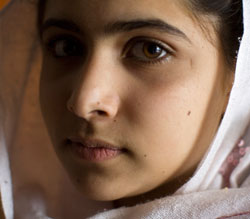Don’t Let Malala Yousafzai’s Voice Be Silenced
 Few of us really ever have to answer the question, “What am I willing to risk my life for.”
Few of us really ever have to answer the question, “What am I willing to risk my life for.”Malala Yousafzai, 11, did answer.
She decided to risk everything and speak for education rights for girls. Malala dreamed of being a doctor. That required her going to school, a right denied to girls in Pakistan’s Swat Valley by the Taliban in 2009. The Taliban sought to shut down schools educating girls. Malala spoke out, continued her education despite the risk, maintained a blog under a pseudonym and inspired other girls to speak out.
Malala had attended a private school for girls run by her father. The Taliban edict resulted in most families being too afraid to send their daughters to school.
For the past three years, Malala has been a voice for girls who could not speak out for themselves. Her work earned her a nomination for the International Children’s Peace Prize and Pakistan’s inaugural National Youth Peace Prize in 2011. She also led a delegation of children’s rights activists, sponsored by the United Nation’s Children’s Fund (UNICEF).
But there were those who wanted to silence Malala, now 14.
For a year, Malala Yousafzai was targeted by the Taliban. On Tuesday she was shot in her village. She is in critical condition. Doctors worked to remove bullets from her head and neck.
It is shocking that in 2012, girls are denied education and banned from schools.
In the United States, education is a right. Often it is taken for granted and sometimes even squandered. And while inequities exist here, in other parts of the world, children are still dying in the struggle for education. It is inexcusable.
Other girls are also fighting for the right to education in the world. We must join in their fight.
Girl Rising, a feature-length film will be released in March of 2013, documenting the stories of 10 girls from 10 countries and their quest for education, despite incredible challenges.
Malala story illustrates the powerful influence of children who envision a life different than their current circumstances and are committed to making a change. We hope that you take advantage of this teachable moment and talk about Malala Yousafzai with your students. Courageous through her fear, Malala sought to change the world.
Throughout history, there have been other examples of children leading the charge for change. In Birmingham, Ala., in 1963, young people stood and walked in spite of the threat of fire hoses, police dogs and arrests to bring segregation to it knees. The story is captured in The Children’s March. These children marched for social change.
Malala stands for peace. She has taken action for education and equity of women and girls in the world. We cannot let Malala’s voice be silenced. What can you do to honor her? How will you stand with her?









































